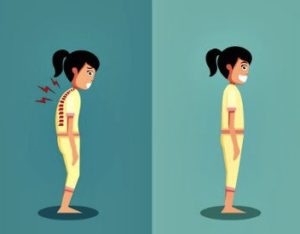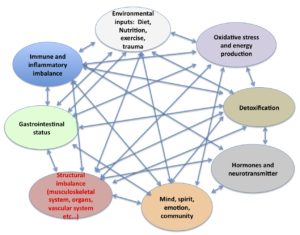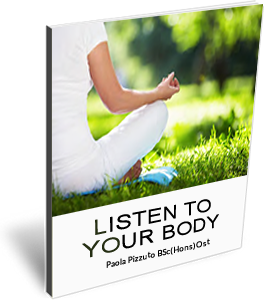
Having a good posture is much more than just looking good!
First of all, let me tell you that there is no perfect posture. The mechanics and physiology of the body are unique to each individual and are both in a constant state of change and adaptation.
I believe that some of our postural habits are set during our childhood and are further shaped later on in life, by lifestyle, emotions, and traumatic events such as surgeries, falls, fractures, etc.
How many times have you tried to correct your posture and managed to hold it right only for few minutes? How many times have you felt unable to make a real shift in your posture and the way your body feels, despite the fact that you stretch, eat well, and try to take care of your body the best you can?
One of the reasons why you can’t assume and hold a good posture for a prolonged amount time might reside in tensions or mal-adaptation patterns that require therapeutic intervention.
Being aware of the way you hold yourself and being able to correct your posture is important. However, due to the life and times that we are living in, to really bring the body back into balance and experience long-lasting health benefits, including a better posture, requires much more than just sitting straight.
The way your body looks and functions and the expression of your health, are the end result of a complex interplay of several factors.
In this article I will give an overview of how an “unbalanced body” can have profound effects on your health, general wellbeing, and posture. In a following post I will explain how some of these patterns can be set in our childhood.
Poor posture could be seen as an adaptation of the body to “faulty” information coming from one or more of the sensory systems of muscles, joints, organs, etc.
The subconscious part of our brain (basal ganglia, brainstem, cerebellum) dictates posture by taking in information from sensory receptors of the body that, in turn, provide kinesthetic (sensation) information about the body’s position in space (proprioception).
Based on neuroscientific findings, it is known that, for example, foot position and weight distribution influence posture and coordination dynamics of the lower limbs, and that the tactile (skin) information of the feet influences oculomotor control (eye movement) and orthostatic balance.
The Musculoskeletal system, a system that comprises the skeleton, its muscles, and various connective tissues that support and bind tissues and organs together, is highly interconnected with other physiological body functions and our emotional state.
Here below is a graphic representation of these interconnections (I have highlighted in red where the musculoskeletal system is).

Picture adapted from: Cleveland clinic medical education
As you can see, it is impossible to draw a clear boundary between organ systems and biochemical vs. nutritional vs. structural (posture included) vs. neurologic processes.
Tensions, anywhere in the body, are the end result of a more complex underlying unbalance that has been protracted for some time and has eventually manifested in musculoskeletal pain and altered posture.
This concept is not very easy to grasp for many of us. The following case is a good example that shows this interconnection.
Mrs X came to see me because, for the last 3 months, she had been feeling “Out of balance” she had been suffering with pain in her left shoulder that would not go away despite the strong painkillers she was prescribed and she felt that her posture had changed.
She considered herself very healthy, she hardly got sick, she had a balanced diet and exercised regularly, she never had any surgery and her annual complete medical check-up was perfect. She had had an x-Ray and an MRI of her shoulder and everything was fine.
She was told that she had a “Mild scoliosis” in her thorax. She suffered menstrual pain that for her was “normal”. In her words: “yes, I do have period pain, but I’m not here for that, I am here for my shoulder pain. Also my GP told me that it’s normal to have some period pain, isn’t it?” She was very frustrated with her shoulder pain and could not understand where it was coming from. Nothing would make it worsen or improve; the pain was there all the time!
Following the osteopathic examination, I explained her that her chest was slightly pulled to the left, that her left kidney was unable to move properly and that, in my opinion, the lack of organ mobility was also affecting her uterus and left ovary and these were the underlying causes of her persistent pain. With great skepticism, she agreed to undergo treatment and, to her amazement, the shoulder and menstrual pain went away and her chest was not pulled to the left any longer.
I finally gained some of her trust and she opened up saying that she had fallen from a horse 10 years back. Since then, she had suffered with anxiety and fear. She noticed that since the osteopathic treatment, these symptoms had almost completely gone, she felt more in control of her life and had a better posture.
When organs are unable to move freely, the physiological processes of our body become affected in a negative way:
- The body becomes less able to utilize its self-regulatory and healing mechanisms, and thus symptoms of various natures ensue,
- The way we hold ourselves, our posture, changes, and we start to use our body in a less efficient way. In the long run, joint pains arise,
- Our emotions become affected too! Patients often say that they feel “trapped in life” or “low and not motivated”, etc.
Similarly, when we experience pain, discomfort, and feel unwell, our posture changes and we develop tensions, affecting the musculoskeletal system.
In my clinical experience I have observed that profound and long-lasting changes in someone’s body (its function and the musculoskeletal structures) happen only when:
- All aspects of your health and life are taken into account and the therapeutic intervention is directed towards areas of the body that are unable to move or function appropriately,
- Various aspects of your lifestyle that need to be modified because they are negatively impacting on your health are discussed and changed by you, the patient.
I like to call this a “therapeutic partnership” with patients.
In my approach I am always concerned about determining the underlying cause or source of your health problem and how I can help you to achieve long-lasting benefits, a balanced body, and, ultimately, good health.
Read what some of my patients say; many of them did not think that their chronic health issues could be improved or eradicated. For many of them, the benefits of the treatment go beyond pain relief, they experience an improvement in their general health.
If you have any health issue that is affecting you and the quality of your life, don’t postpone it further! Get in touch to find out how I can help you. Make your health your top priority!
When you feel good, life becomes more enjoyable!
Paola Pizzuto, Registered Osteopath
Connect with me on Facebook where I share lots of useful information
 Receive for free the e-book I have specifically written for you, to help you learn more about the uniqueness and preciousness of your body and start a new journey of greater health and happiness. Your email is not shared with third parties and stored a GDPR compliant service provider (AWeber).
Receive for free the e-book I have specifically written for you, to help you learn more about the uniqueness and preciousness of your body and start a new journey of greater health and happiness. Your email is not shared with third parties and stored a GDPR compliant service provider (AWeber).
Ciao Paola, sono Giorgia da Bury St Edmunds. Volevo farti i complimenti per essere riuscita a realizzare i toui sogni. che meravglia, bravissima. Io sono molto interessata nella medicina naturale e ci credo pienamente. Dopo aver letto i tuoi articoli sono sicura che , visti i problemi di mio marito, quello di cui ha veramente bisogno e di un osteopata come te. Purtroppo io non posso venire ad Edinburgo, anche se e un posto che adoro veramente. Sapresti consigliarmi dove rivolgermi qui a Bury St Edmunds? Tu non vieni mai qui immagino. Spero di non averti disturbato. Come stai? Spero la vita ti sorrida . Ti abbrraccio forte. Giorgia
Giorgia! grazie delle tue parole.non mi disturbi mai! ti mando messaggio su facebook!